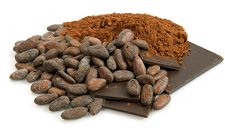Chocolate Definitions
October 29, 2009
Confusion in the world of chocolate?
You might think, "there’s nothing confusing about chocolate -- you buy it, you eat it!" The reality is, the chocolate world has its own lingo, with terms and definitions that apply to the tasting of chocolate, the baking and cooking of chocolate, and the making of chocolate confections.
 To help you keep it all straight, here is a list of some common chocolate vocabulary along with their definitions...
To help you keep it all straight, here is a list of some common chocolate vocabulary along with their definitions...
Cocoa bean (or nib):
The cocoa bean is the seed from the pod, or fruit, of the chocolate tree -- Theobroma cacao. The cocoa bean has a shell surrounding it. When it is removed, the nib, or the center, is revealed. The nib is typically roasted and then crushed into chocolate liquor.
Baking chocolate (or chocolate liquor):
Baking chocolate is made from finely ground and roasted cocoa beans. There is no sugar in baking chocolate.
Cocoa butter:
The fat present in cocoa beans is called cocoa butter. The term “butter” does not mean that cocoa butter is a dairy product.
Cocoa powder:
Cocoa powder comes from removing the cocoa butter from the nib and then grinding the remaining solids into a powder. The terms cocoa and cocoa powder can be used interchangeably.
Bittersweet (or semi-sweet) chocolate:
Bittersweet chocolate must contain at least 35% chocolate liquor and only cocoa butter as a fat, according to U.S. Standards of Identity. Both bittersweet and semi-sweet chocolate terms can be used interchangeably.
Milk chocolate:
The most commonly consumed form of chocolate is milk chocolate. Milk chocolate must contain a minimum of 10% chocolate liquor and at least 12% milk solids. Milk fat and cocoa butter are the only fats that can be used.
White chocolate:
White chocolate is a blend of cocoa butter, milk, and sugar. There are no chocolate solids present, which is why it lacks the typical brown color of chocolate. U.S. regulations requires white chocolate to contain at least 20% (by weight) cocoa butter and at least 14% total milk solids.
Dutch processed chocolate:
This process darkens the color of the chocolate and releases a milder chocolate flavor. The chocolate liquor or cocoa solids are treated with an alkaline solution. The terms "dutched" or "alkalized" are listed on the ingredient statement for products sold in the U.S.
Chocolate flavored coating (or confectionary coating):
Chocolate that is made using a blend of vegetable fats either in addition to or other than cocoa butter. Chocolate flavored coatings are similar in color to “real” chocolate coatings but taste very different and usually do not need to be tempered. These coatings that contain vegetable fats cannot legally be called "chocolate" in the US.
- BarkThins Dark Chocolate Coconut with Almonds - May 22, 2020
- Endangered Species Cacao Nibs + Dark Chocolate Review - May 15, 2020
- Mr. Dot Bar Review - May 7, 2020

